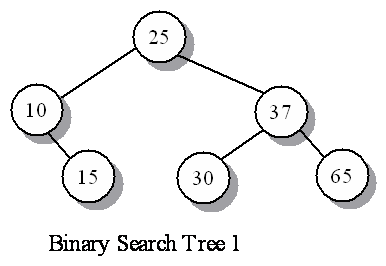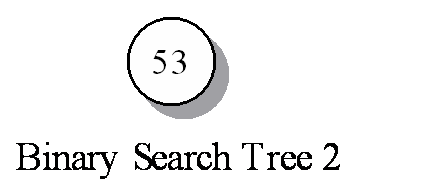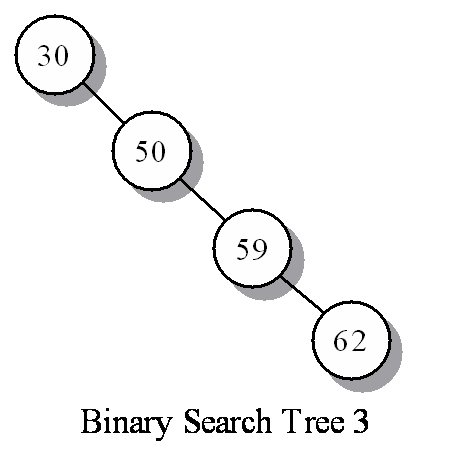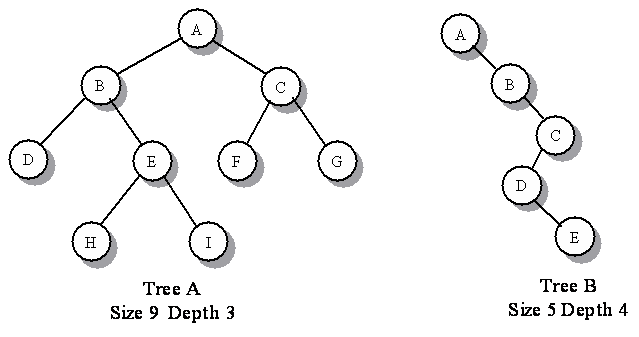
| binary tree | A binary tree is a tree in which each node has two children, possibly absent, named the left child and the right child. |
| complete binary tree | A complete binary tree is is a binary tree of depth n where all nodes in levels 0 through n - 1 levels inclusive have degree 2 and nodes at level n occupy the leftmost positions in the tree. |
| full binary tree | A full binary tree is a binary tree in which all leaves have the same depth and all internal nodes have degree 2. |
| balanced binary tree | A balanced binary tree is binary tree where the depth of all leaves is the same or 1 plus the least. |
| degenerate binary tree | A degenerate binary tree is a binary tree in which each node has 1 child. |

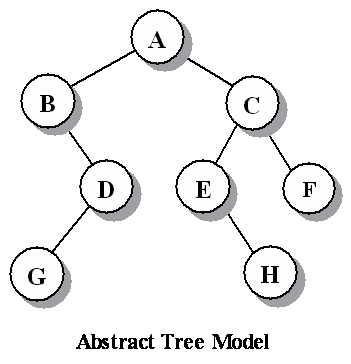
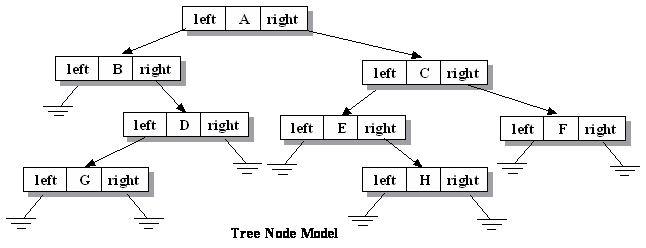
At each level d there may be from 1 to 2d nodes.
| level 0: | 1 to 20 | = 1 node |
| level 1: | 1 to 21 | = 2 nodes |
| level 2: | 1 to 22 | = 4 nodes |
| level 3: | 1 to 23 | = 8 nodes |
| etc. |
In a full binary tree of height d there will be 2(d + 1) - 1 nodes.
Consider a tree of height 3.
1 + 2 + 4 + 8 = 15 = 24 - 1
We can recall binary to decimal conversion as a memory aid.
Example, convert 1001 to base 10:
8 4 2 1
1 0 0 1two = 8 + 0 + 0 + 1 = 9
or
23 22 21 20
1 0 0 1two = 23 + 0 + 0 + 20 = 9
Consider,
convert 1111 to base 10:
8 4 2 1
1 1 1 1two = 8 + 4 + 2 + 1 = 15
or
23 22 21 20
1 1 1 1two = 23 + 22 + 21 + 20 = 15
Note:
24 23 22 21 20
1 1 1 1two
+ 1two
-----------
1 0 0 0 0two = 24 = 16
10000two = 1111two + 1two
10000two - 1two = 1111two
So,
24 - 1 = 23 + 22 + 21 + 20
And, in general,
2(d + 1) - 1 = 2d + 2d - 1 + ... + 21 + 20
In a complete binary tree of height d there will be at least 2d nodes. Levels through d - 1 form a full tree and there is at least 1 node in the next level (at the left).
Using the above formula, in the complete part of the tree there are:
2[(d - 1) + 1] - 1 = 2d - 1
nodes. Adding one more we get:
2d - 1 + 1 = 2d
Thus in a complete binary tree the number of nodes, n is:
2d <= n <= 2(d + 1) - 1 < 2(d + 1) or 2d <= n < 2(d + 1)
Given the number of nodes, what is the depth of a complete binary tree?
log2(2d) <= log2(number of nodes) < log2(2(d + 1))
d <= log2(n) < d + 1
Since the depth must be a whole number we get the following,
where n is the number of nodes and
int() means discard the fractional part.
Depth of a complete binary tree:
d = int(log2(n))
Consider a complete binary tree that has 15 nodes.
(Draw it and compute d = int(log2(n))).
For a full binary tree, with n nodes and height h,
